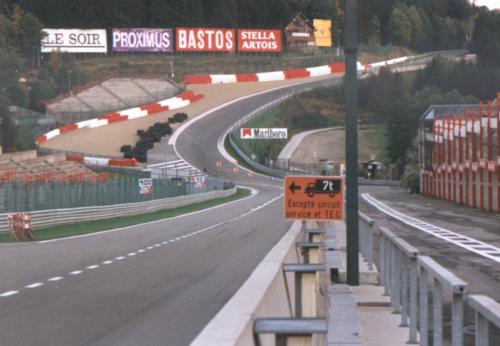Spa-Francorchamps is the most complete test of a Formula One car on the current calendar with every aspect of the vehicle's handling tested to the limit. It combines 320 km/h straights with 70 km/h hairpins, with several sixth-gear sweepers thrown in for good measure - and, of course, the unique challenge of Eau Rouge. While this section of the circuit and the fast left-hander at Blanchimont may no longer be as testing as they once were, corners such as Pouhon, taken blind in sixth gear, still allow the drivers to make the difference. And all of that is before you factor in the notoriously unpredictable weather in the Ardennes, which can see the circuit soaked at one end and bone dry at the other. Here Renault describe how they plan to set-up the R28 to cope with the Belgian circuit’s demands…
Chassis:
The circuit features a high number of ‘aero corners’ (only six of the 19 turns are taken at less than 150 km/h), and this would normally push the teams towards relatively high levels of downforce in order to maximise grip in the corners, as is the case at a circuit like Silverstone for example. However, Spa imposes a very different trade-off, because the two long flat-out ‘straights’ on the circuit both provide genuine overtaking opportunities. This means that top-speed is a critical factor in order to protect position, and downforce levels must be determined accordingly. As a result, the teams run with a medium downforce set-up, aiming to achieve end of straight speeds of around 320 km/h. Aerodynamic efficiency (generating maximum downforce for minimum drag) is the key to success at this circuit.
Suspension:
In terms of suspension settings, the overall compromise is relatively stiff in order to ensure good aerodynamic performance in the quicker corners, and a good change of direction in the quick chicanes. However, good traction is also critical on the exit of the final chicane and La Source hairpin, as poor performance in either part of the circuit can leave a driver vulnerable to overtaking under braking for the next corner.
Tyres:
Along with Barcelona, Spa is the most demanding circuit of the season for the tyres, and it is no surprise that Bridgestone will bring the two hardest compounds from its 2008 range for this race: the hard and medium compounds.
Ride heights:
Our ride heights are limited by the high forces encountered through the compression in Eau Rouge. From the bottom to the top of the hill, the car's ride height can vary by as much as 25 mm and if the car bottoms out too much, the drivers can lose control. With the V8 engines and the current aerodynamic regulations, Eau Rouge is now taken easily flat out at around 300 km/h. The drivers will scrub off around 10 km/h through the sequence, but it is important to conserve as much speed as possible in order to maintain position along the long straight before Les Combes.
Brakes:
Almost the only part of the car which has a relatively easy time is the braking system. The circuit features just three very heavy braking events, before Turns One, Five and 18. Overall, though, this is one of the easiest circuits for the brakes owing to the numerous high speed corners that require little braking effort.
Engine:
Along with Monza, Spa is the most demanding circuit of the season for the V8 engines. The duty cycle is particularly severe, with 72 percent of the lap spent at full throttle (only Monza exceeds this figure, with 76 percent of the lap). Furthermore, this includes two prolonged full throttle periods of over 20 seconds. The most challenging of these is undoubtedly the run of approximately 23 seconds from La Source to Les Combes, which includes Eau Rouge. This sequence exposes the engine and its ancillaries to extreme positive and negative vertical 'g' forces through the compression and over the crest that follows. This is a factor we take into account when designing our lubrication systems, in order to avoid problems with oil feed under the extreme loadings.
Spa is also the longest lap of the season, and the circuit has a very high fuel mass penalty. Under the current qualifying regulations, this means that an engine with good fuel consumption can be a particular advantage.
Source : F1.com














